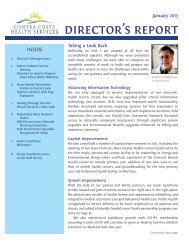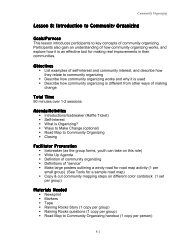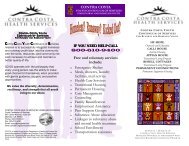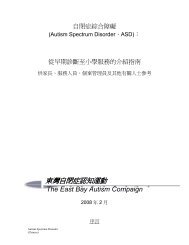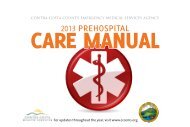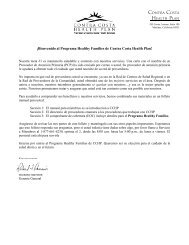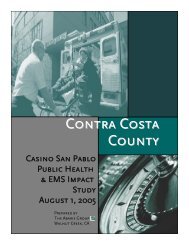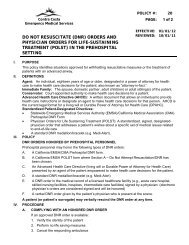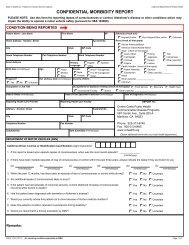EMS Policy Manual - Contra Costa Health Services
EMS Policy Manual - Contra Costa Health Services
EMS Policy Manual - Contra Costa Health Services
You also want an ePaper? Increase the reach of your titles
YUMPU automatically turns print PDFs into web optimized ePapers that Google loves.
<strong>Contra</strong> <strong>Costa</strong><br />
Emergency Medical <strong>Services</strong><br />
POLICY #: 14<br />
PAGE: 2 of 4<br />
B. Pediatric Patients (below age 15) appropriate for Emergency Trauma Re-Triage to the Pediatric<br />
Trauma Center (Children’s Hospital and Research Center, Oakland) include:<br />
1. Hemodynamic Criteria<br />
a. Patients with abnormal blood pressure or poor perfusion (see age-appropriate vital<br />
signs chart below). Pediatric clinical signs of poor perfusion include: cool, mottled,<br />
pale or cyanotic skin or prolonged capillary refill, low urine output, or lethargy<br />
b. Requirement of more than two crystalloid boluses (20 ml/kg each) or requirement of<br />
blood transfusion (10 ml/kg)<br />
2. Neurologic criteria<br />
a. GCS < 12 (pediatric scale – see verbal for young children below) or decrease in<br />
GCS by 2<br />
b. Blown pupil<br />
c. Obvious open skull fracture<br />
d. Cervical spine injury with neurologic deficit<br />
3. Respiratory Criteria<br />
a. Respiratory failure<br />
b. Intubation required<br />
4. Anatomic Criteria<br />
a. Penetrating wound to the head, neck, chest, or abdomen<br />
5. Patients, who in the judgment of the evaluating emergency physician, are anticipated to<br />
have a high likelihood for emergent life- or limb-saving surgery or other intervention within<br />
two (2) hours.<br />
6. Exceptions<br />
a. Pregnant pediatric patients should be transferred to an adult trauma center<br />
b. Pediatric patients with burns should preferentially be transferred to a burn center<br />
instead of a trauma center<br />
c. Contact the trauma center to discuss patients with suspected vascular injuries<br />
V. RE-TRIAGE PROCEDURE<br />
A. Once the patient has been identified as qualifying for Emergency Trauma Re-triage, the trauma<br />
center should be contacted (see contact list and phone numbers below) as soon as possible<br />
and the patient should be specifically identified as an “Emergency Trauma Re-Triage.” Based<br />
on that notification (and that the center is not on trauma bypass), the patient will be accepted for<br />
transfer.<br />
B. Simultaneous or as soon as possible following notification of the trauma center, the appropriate<br />
transport provider should be contacted to arrange transport. Depending on the needs of the<br />
patient, the transport unit may be a 9-1-1 paramedic unit, EMT unit, CCT-RN unit or Air<br />
Ambulance.<br />
C. Patient records and diagnostic imaging disks (if available) should be readied for transport<br />
personnel. Records that are not ready at time of transport departure can be faxed.



